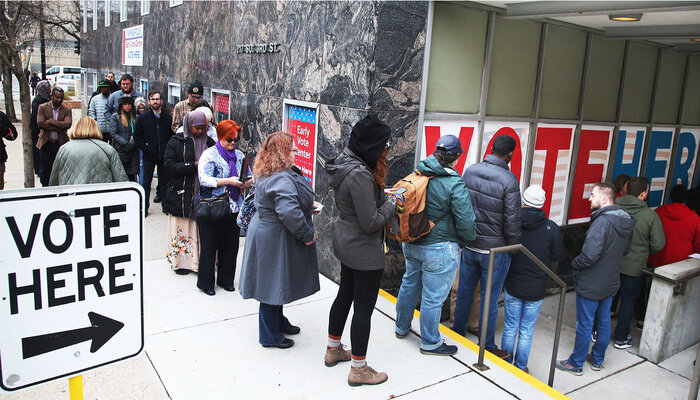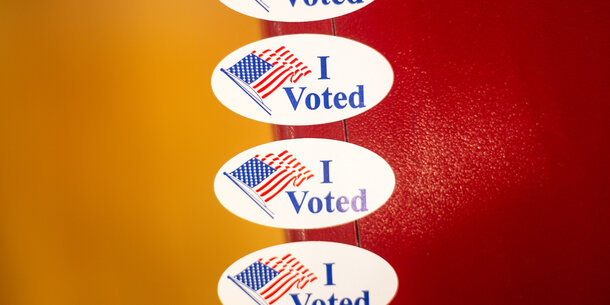For too many Americans, it’s still too hard to vote. Two years ago, on the anniversary of the historic civil rights demonstration in Alabama known as Bloody Sunday, President Biden targeted this serious problem with an executive order committing the federal government to expanding voter registration and voting information access.
Building on 1993’s “motor voter law,” the order directs federal agencies to implement creative approaches to making it easier to apply to register to vote, obtain information about voting, and participate in the electoral process.
Amid the current impasse on federal voting rights legislation, robust implementation of this executive order is the primary tool the federal government has to ensure that every eligible voter has access to the ballot box before the next presidential election. There’s been some progress, but the administration needs to do much more — and the clock is ticking.
The executive order is one of the most substantial undertakings by any administration to overcome barriers to voting, many of which disproportionately affect people of color, low-income people, and those with disabilities or limited English proficiency. The order outlines specific actions federal agencies can take to increase opportunities to engage in the democratic process.
To see how it’s going so far, last week a group of voting rights and other organizations released a new report detailing what has been done and what is still needed from agencies to ensure every eligible American has easy access to voter registration, voting information, and voting itself.
For example, the Department of the Interior’s Bureau of Indian Education will offer voter registration services at tribal universities, and the Department of Veterans Affairs will do the same at health facilities. However, while the Department of Health and Human Services committed to provide voter registration opportunities as part of the healthcare.gov application process well over a year ago, it has yet to do so. Similarly, U.S. Citizenship and Immigration Services has yet to provide access to voter registration services at or after all naturalization ceremonies, and Indian Health Services has yet to provide voter registration services at its facilities.
Of particular importance are the General Services Administration’s efforts to modernize vote.gov. The site is the federal government’s single national source for voting information and also provides access to voter registration application opportunities for every state. Once upgraded, this website will be a trusted, user-friendly, accessible, and secure venue for comprehensive access to and information on registration and voting.
The specifics of the executive order envision vote.gov as a website where any eligible citizen can access voter registration opportunities. In its upgraded version, the government should provide user-friendly online services that are also accessible for people with disabilities or limited English proficiency. Critically, if properly upgraded, it will provide people who cannot access their own state’s voter registration systems with the tools and information they need to register to vote, and it will also serve as a key to unlocking the potential of various federal agencies’ ability to offer voter registration access.
State voter registration systems are not always accessible for people with disabilities or limited English proficiency. They can also be a challenge for low-income people who live in states without online voter registration, such as Mississippi or South Dakota. For example, eligible citizens may live far from or not have transportation to travel to physical offices to pick up a paper voter registration application and may lack access to technology that would allow downloading and printing that same form. The result is that some eligible citizens fall through the cracks.
By creating vote.gov as a single location where any eligible voter can easily access and use a voter registration application — no matter their background, language spoken, physical capabilities, or geography — the federal government can provide a fail-safe that has never before existed in this country.
With vote.gov modernized in this manner, the simplest and easiest way for other federal agencies to provide voter registration access to the people they engage with is to direct them to vote.gov rather than reinventing the wheel by developing and coding their own independent voter registration resources.
The General Services Administration’s current vision for the modernization of vote.gov — to create a more accessible, equitable, and usable tool to access voter registration — is a good starting point but should be more ambitious. To date, the agency has translated vote.gov into 12 languages, including 2 Native American and Alaska Native languages.
For the remainder of the year, the agency aims to make crucial improvements to the National Mail Voter Registration Form, which can be used to register to vote in almost every state. The changes, being done in collaboration with the U.S. Election Assistance Commission, would make it a more accessible digital form rather than a downloadable PDF, with an integrated digital form filler on vote.gov. This would reduce the burden for those with vision impairments or cognitive disabilities who have trouble accessing PDFs. The agency also plans to create a series of voter registration guides for people who experience barriers to voting, and it will incorporate information into the site to help people better understand how voting and elections work.
While the General Service Administration’s plans include important improvements, there is significantly more to be done. The vote.gov modernization was stalled for several months and the current work needs to be expedited. Additional tools, including signature capture for the National Mail Voter Registration Form, must be added to ensure that vote.gov becomes a one-stop location for any eligible citizen to access and complete a voter registration application.
To strengthen every American’s constitutional right to vote, the General Services Administration must prioritize making these advancements. Other agencies, from the Department of Health and Human Services to the Department of Education, must also do more as detailed in the new report and coalition letter from nearly 100 groups sent to the president.
The Biden administration is already in the second half of its term. Protecting our democracy can’t wait.





